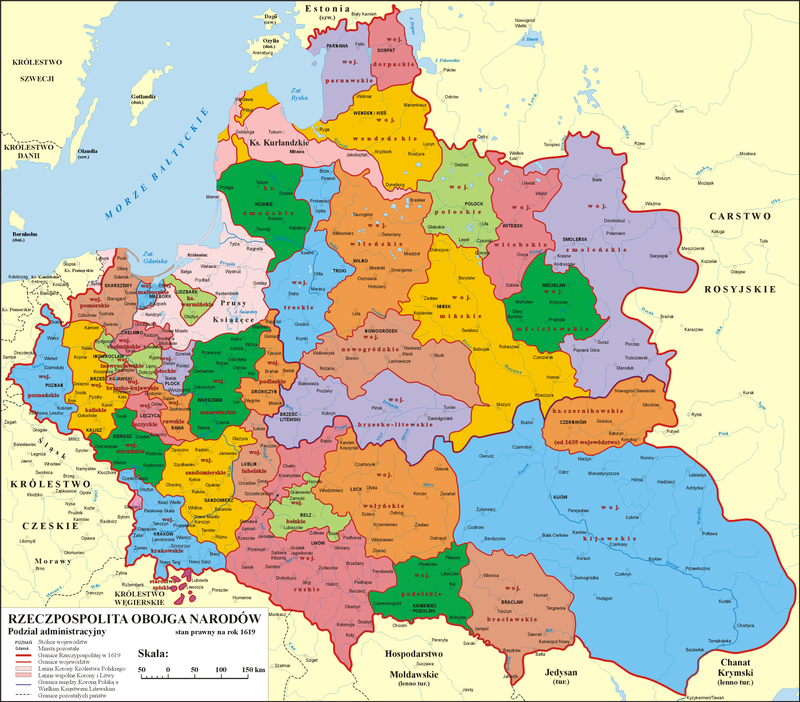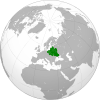User:Rrobi333/sandbox
Grand Empire of Poland
Empire of Poland Imperium Polskie | |
|---|---|
| Motto: "Si Deus nobiscum quis contra nos" | |
| Anthem: " Canadian | |
| Religion | |
Prime Minister | Mateusz Morawiecki |
| Legislature | |
| Sejm | |
| Senat | |
| Area | |
• Total | 1,153,465 km2 (445,355 sq mi) (25nd) |
| Population | |
• 2018 estimate | |
• Density | 117/km2 (303.0/sq mi) (90th) |
| GDP (PPP) | 2018 estimate |
• Total | $5,314. trillion (5th) |
• Per capita | $39,451 (30th) |
| GDP (nominal) | 2018 estimate |
• Total | $5.104 trillion (3th) |
• Per capita | $37,894 (24th) |
| Gini (2018) | 29.5 low |
| HDI (2018) | very high (6th) |
| Currency | Euro (€) (EUR) |
| Time zone | UTC+1 (CET) |
• Summer (DST) | UTC+2 (CEST) |
| Driving side | right |
| Calling code | +48 |
| ISO 3166 code | PL |
| Internet TLD | .pl and .eu |
Poland , officially the Empire of Poland (Polish:
The establishment of a Polish state can be traced back to 966, when
Poland is a
.Etymology
The origin of the name Poland derives from the
Geography

Poland's territory extends across several geographical regions, between latitudes 49° and 55° N, and longitudes 14° and 25° E. In the north-west is the Baltic seacoast, which extends from the Bay of Pomerania to the Gulf of Gdańsk. This coast is marked by several spits, coastal lakes (former bays that have been cut off from the sea), and dunes. The largely straight coastline is indented by the Szczecin Lagoon, the Bay of Puck, and the Vistula Lagoon.
The centre and parts of the north of the country lie within the North European Plain. Rising above these lowlands is a geographical region comprising four hilly districts of moraines and moraine-dammed lakes formed during and after the Pleistocene ice age. These lake districts are the Pomeranian Lake District, the Greater Polish Lake District, the Kashubian Lake District, and the Masurian Lake District. The Masurian Lake District is the largest of the four and covers much of north-eastern Poland. The lake districts form part of the Baltic Ridge, a series of moraine belts along the southern shore of the Baltic Sea.
South of the Northern European Plain are the regions of
Geology

The geological structure of Poland has been shaped by the

Poland has 70 mountains over 2,000 metres (6,600 feet) in elevation, all in the
The second highest mountain group in Poland is the
Other notable uplands include the
The lowest point in Poland – at 1.8 metres (5.9 ft) below sea level – is at Raczki Elbląskie, near Elbląg in the Vistula Delta.
In the
The Baltic Sea activity in
Waters
The
Poland's rivers have been used since early times for navigation. The
In the valley of Pilica river in Tomaszów Mazowiecki there is a unique natural karst spring of water containing calcium salts, that is an object of protection in Niebieskie Źródła Nature Reserve in Sulejów Landscape Park. The origin of the name of the reserve Niebieskie Źródła, that means Blue Springs, comes from the fact that red waves are absorbed by water and only blue and green are reflected from the bottom of the spring, giving that atypical colour.
With almost ten thousand closed bodies of water covering more than 1 hectare (2.47 acres) each, Poland has one of the highest numbers of lakes in the world. In Europe, only Finland has a greater density of lakes. The largest lakes, covering more than 100 square kilometres (39 sq mi), are Lake Śniardwy and Lake Mamry in Masuria, and Lake Łebsko and Lake Drawsko in Pomerania.

In addition to the lake districts in the north (in Masuria, Pomerania, Kashubia, Lubuskie, and Greater Poland), there is also a large number of mountain lakes in the Tatras, of which the Morskie Oko is the largest in area. The lake with the greatest depth—of more than 100 metres (328 ft)—is Lake Hańcza in the Wigry Lake District, east of Masuria in Podlaskie Voivodeship.
Among the first lakes whose shores were settled are those in the Greater Polish Lake District. The stilt house settlement of Biskupin, occupied by more than one thousand residents, was founded before the 7th century BC by people of the Lusatian culture.
Lakes have always played an important role in Polish history and continue to be of great importance to today's modern Polish society. The ancestors of today's Poles, the

The Polish Baltic coast is approximately 528 kilometres (328 mi) long and extends from Świnoujście on the islands of Usedom and Wolin in the west to Krynica Morska on the Vistula Spit in the east. For the most part, Poland has a smooth coastline, which has been shaped by the continual movement of sand by currents and winds. This continual erosion and deposition has formed cliffs, dunes, and spits, many of which have migrated landwards to close off former lagoons, such as Łebsko Lake in Słowiński National Park.
Prior to the end of the Second World War and subsequent change in national borders, Poland had only a very small coastline; this was situated at the end of the 'Polish Corridor', the only internationally recognised Polish territory which afforded the country access to the sea. However, after World War II, the redrawing of Poland's borders and resulting 'shift' of the country's borders left it with an expanded coastline, thus allowing for far greater access to the sea than was ever previously possible. The significance of this event, and importance of it to Poland's future as a major industrialised nation, was alluded to by the 1945 Wedding to the Sea.
The largest spits are
Administrative divisions
Poland's current voivodeships (provinces) are largely based on the country's historic regions, whereas those of the past two decades (to 1998) had been centred on and named for individual cities. The new units range in area from less than 10,000 square kilometres (3,900 sq mi) for Opole Voivodeship to more than 35,000 square kilometres (14,000 sq mi) for Masovian Voivodeship. Administrative authority at voivodeship level is shared between a government-appointed voivode (governor), an elected regional assembly (sejmik) and an executive elected by that assembly.
The voivodeships are subdivided into powiats (often referred to in English as counties), and these are further divided into gminas (also known as communes or municipalities). Major cities normally have the status of both gmina and powiat. Poland has 16 voivodeships, 1179 powiats (including 165 cities with powiat status), and 7,478 gminas.
| No. | Voivodeship | Area | Population | Capital | Density |
|---|---|---|---|---|---|
| 1. | 200,000 | 24,584,087 | Kiev |
||
| 1. | 83,000 | 5,415,987 | Smoleńsk |
||
| 1. | Mińsk Voivodeship |
55,500 | 7,851,012 | Mińsk | |
| 1. | 55,200 | 9,051,084 | Lviv | ||
| 1. | Czernihów Voivodeship |
46,541 | 899,021 | Czernichów | |
| 1. | 44,200 | 3,055,349 | Vilnius | ||
| 1. | Brześć Litewski Voivodeship |
40,600 | 2,312,577 | Brześć |
|
| 1. | 38,324 | 2,159,211 | Łuck |
||
| 1. | 33,200 | 1,548,087 | Nowogródek |
||
| 1. | 32,493 | 5,894,021 | Królewiec | ||
| 1. | 31,660 | 2,598,004 | Winnica | ||
| 1. | Troki Voivodeship |
31,100 | 1,575,008 | Kowno |
|
| 1. | 30,000 | 3,004,874 | Ryga |
||
| 1. | Duchy of Courland |
27,286 | 1,321,012 | Jelgava | |
| 1. | Witebsk Voivodeship |
24,600 | 2,087,012 | Witebsk |
|
| 1. | 23,860 | 3,508,127 | Kelce | ||
| 1. | 23,300 | 2,371,045 | Szawle |
||
| 1. | 23,200 | 12,957,891 | Warsaw | ||
| 1. | Mścisław Voivodeship |
22,600 | 1,187,077 | Mohylew |
|
| 1. | Połock Voivodeship |
21,800 | 1,858,012 | Połock |
|
| 1. | Podole Voivodeship |
17,770 | 1,097,354 | Kamieniec Podolski |
|
| 1. | 17,650 | 8,458,214 | Kraków | ||
| 1. | 15,320 | 2,987,214 | Kalisz | ||
| 1. | 15,015 | 3,897,048 | Poznań | ||
| 1. | 12,907 | 5,189,357 | Danzig |
||
| 1. | 12,000 | 1,231,854 | Parnawa |
||
| 1. | 10,230 | 1,307,002 | Lublin | ||
| 1. | 9,700 | 1,025,854 | Sieradz | ||
| 1. | 9,000 | 1,012,085 | Tartu | ||
| 1. | Bełz Voivodeship |
9,000 | 898,021 | Zamość | |
| 1. | 6,200 | 578,214 | Rawa Mazowiecka | ||
| 1. | 5,877 | 1,558,247 | Bydgoszcz | ||
| 1. | 4,080 | 1,587,214 | Łódź | ||
| 1. | 4,654 | 1,097,584 | Toruń | ||
| 1. | 4,500 | 721,845 | Olsztyn | ||
| 1. | Płock Voivodeship |
3,591 | 1,004,845 | Płock | |
| 1. | Starostwo Spiskie |
3,570 | 389,214 | Poprad | |
| 1. | 3,000 | 298,214 | Brześć Kujawski | ||
| 1. | 2,096 | 696,648 | Elbląg | ||
| 1. | 14,321 | 1,208,321 | Białystok |
Corporations
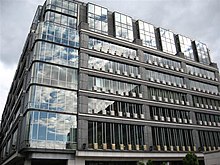
Poland is recognised as a regional economic leader within Central Europe, with nearly 40 percent of the 500 biggest companies in the region (by revenues) as well as a
The economic transition in 1989 has resulted in a
Well known Polish brands include, among others
.Tourism
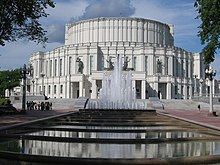
Poland experienced an increase in the number of tourists after joining the European Union in 2004. Tourism contributes significantly to the overall economy and makes up a relatively large proportion of the country's service market. Poland is the 16th most visited country in the world by foreign tourists, as ranked by World Tourism Organization (
Tourist attractions in Poland vary, from the mountains in the south to the sandy beaches in the north, with a trail of nearly every architectural style. The most visited city is
Poland's main tourist offerings include outdoor activities such as skiing, sailing, mountain hiking and climbing, as well as agrotourism, sightseeing
Transport

Transport in Poland is provided by means of
Since joining the EU in May 2004, Poland has invested large amounts of public funds into modernization projects of its transport networks. The country now has a developing network of highways, composed of express roads and motorways such as A1, A2, A4, A6, A8, A18. At the end of 2017, Poland had 3421,7 km of highways. In addition to these newly built roads, many local and regional roads are being fixed as part of a national programme to rebuild all roads in Poland.

In 2015, the nation had 19,000 kilometres (11,800 mi) of railway track. Trains can operate up to 160 km/h (99 mph) on 7.5% of the track. Most trains operate between 80 and 120 km/h (50 and 75 mph). Part of the system operates at 40 km/h (25 mph). Polish authorities maintain a program of improving operating speeds across the entire Polish rail network. To that end,

On 14 December 2014, Polish State Railways started passenger service using the PKP Pendolino ED250, operating at 300 km/h speed on 80 km of line between Olszamowice and Zawiercie (part of the
The air and maritime transport markets in Poland are largely well developed. Poland has a number of international airports, the largest of which is
Seaports exist all along Poland's Baltic coast, with most freight operations using Szczecin, Świnoujście, Gdynia and Gdańsk as well as Police, Kołobrzeg and Elbląg as their base. Passenger ferries link Poland with Scandinavia all year round; these services are provided from Gdańsk and Świnoujście by Polferries, Stena Line from Gdynia and Unity Line from the Port of Świnoujście.
Airports with commercial passenger service
| City served | Voivodeship | Location | Airport name | Passengers (2017) |
|---|---|---|---|---|
| Warsaw | Masovian | Okęcie | Warsaw Chopin Airport | 45,752,000 |
| Kraków | Lesser Poland | Balice | John Paul II International Airport Kraków–Balice
|
26,835,000 |
| Kijów | Kijowskie | Boryspol
|
Copernicus International Airport | 21,012,845 |
Ryga
|
Wenden | Ryga
|
Filippo Buonaccorsi International Airport | 17,854,000 |
| Gdańsk | Pomeranian | Rębiechowo | Gdańsk Lech Wałęsa Airport | 14,600,000 |
Wilno
|
Wileńskie | Wilno
|
Adam Mickiewicz Airport | 10,155,000 |
| Mińsk | Mińskie
|
Mińsk | Anna Jagiellon Airport | 9,542,000 |
| Warsaw | Masovian | Modlin
|
Warsaw-Modlin Airport
|
8,932,000 |
| Poznań | Greater Poland | Ławica | Poznań–Ławica Henryk Wieniawski Airport
|
5,450,000 |
Smoleńsk
|
Smoleńskie | Smoleńsk
|
Potocki Airport | 5,325,000 |
| Kijów | Kijowskie | Żuliany | Rubinstein International Airport
|
5,321,200 |
Lwów
|
Ruthenian | Lwów
|
Lviv Fredro Airport
|
4,212,000 |
Zaporoże
|
Kijowskie | Zaporoże
|
Pola Negri International Airport
|
2,582,010 |
Kowno
|
Trockie
|
Kowno
|
Witkacy Airport | 2,222,000 |
| Dnipro | Kijowskie | Dnipro | Carroll Baker Airport
|
2,008,000 |
| Rzeszów | Ruskie
|
Jasionka | Rzeszów-Jasionka Airport
|
1,942,000 |
| Lublin | Lublin | Świdnik | Lublin Airport | 1,390,000 |
| Bydgoszcz | Inowrocławskie
|
Szwederowo | Bydgoszcz Ignacy Jan Paderewski Airport | 1,021,000 |
| Stanisławów | Ruthenian | Stanisławów | Wisława Szymborska International Airport | 1,015,000 |
| Łódź | Łódzkie | Lublinek | Łódź Władysław Reymont Airport | 792,000 |
| Winnica | Bracławskie | Winnica | Casimir III the Great Airport | 452,000 |
| Olsztyn | Warmian
|
Szymany | Olsztyn-Mazury Regional Airport
|
315,000 |
| Radom | Sandomierskie | Sadków | Radom Airport
|
311,000 |
Krzywy Róg
|
Kijowskie | Krzywy Róg
|
Ignacy Domeyko International Airport | 250,000 |
| Równe | Volhynian | Równe | Max Factor International Airport | 125,000 |
Polish Kings and Emperior
| Image | Monarch | Lifespan | Reign | Wife | House | Children |
|---|---|---|---|---|---|---|

|
Mieszko I of Poland Mieszko I |
1 January 930 – 25 May 992 (aged 60) |
1 January 960 – 25 May 992 (aged 32) |
Doubravka of Bohemia Oda of Haldensleben |
House of Piast
|
|

|
Bolesław I the Brave Bolesław I Chrobry |
1 January 967 – 17 June 1025 (aged 58) |
25 May 992 – 17 June 1025 (aged 33) |
Emnilda of Lusatia
Oda of Meissen |
House of Piast
|
Bezprym Regelinda Otto Bolesławowic |

|
Mieszko II Lambert Mieszko II Lambert |
1 January 990 – 11 May 1034 (aged 44) |
25 May 1025 – 11 May 1034 (aged 8) |
Richeza of Lotharingia | House of Piast
|
Gertruda, Grand Princess of Kiev |
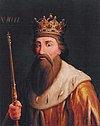
|
Casimir I the Restorer Kazimierz I Odnowiciel |
25 July 1016 – 28 November 1058 (aged 42) |
11 May 1034 – 28 November 1058 (aged 24) |
Maria Dobroniega of Kiev | House of Piast
|
|

|
Bolesław II the Generous Bolesław II Szczodry |
1 January 1042 – 2 April 1081 (aged 39) |
28 November 1058 – 2 April 1081 (aged 22) |
Wyszesława of Kiev | House of Piast
|
Mieszko Bolesławowic |

|
Władysław I Herman Władysław I Herman |
1 January 1044 – 4 June 1102 (aged 58) |
2 April 1081 – 4 June 1102 (aged 21) |
Judith of Bohemia Judith of Swabia |
House of Piast
|
Zbigniew of Poland Agnes I, Abbess of Quedlinburg |

|
Bolesław III Wrymouth Bolesław III Krzywousty |
20 August 1086 – 28 October 1138 (aged 52) |
4 June 1102 – 28 October 1138 (aged 36) |
Zbyslava of Kiev Salomea of Berg |
House of Piast
|
|

|
Mieszko III the Old Mieszko III Stary |
1 January 1126 – 13 March 1202 (aged 76) |
28 October 1138 – 13 March 1202 (aged 63) |
Elisabeth of Hungary
Eudoxia of Kiev |
House of Piast
|
|
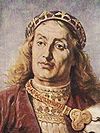
|
Władysław III Spindleshanks Władysław III Laskonogi |
1 January 1166 – 3 November 1231 (aged 65) |
13 March 1202 – 3 November 1231 (aged 29) |
Lucia of Rügen | House of Piast
|
— |
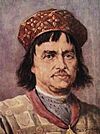
|
Bolesław V the Chaste Bolesław Wstydliwy |
21 June 1226 – 7 December 1279 (aged 53) |
3 November 1231 – 7 December 1279 (aged 48) |
Kinga of Poland | House of Piast
|
— |

|
Władysław I the Elbow Władysław I Łokietek |
1 January 1261 – 2 March 1333 (aged 72) |
7 December 1279 – 2 March 1333 (aged 53) |
Jadwiga of Kalisz | House of Piast
|
|

|
Casimir III the Great Kazimierz III Wielki |
30 April 1310 – 5 November 1370 (aged 60) |
2 March 1333 – 5 November 1370 (aged 37) |
House of Piast
|
Elizabeth, Duchess of Pomerania | |

|
Louis I of Hungary Ludwik Węgierski |
5 March 1326 – 10 September 1382 (aged 56) |
5 November 1370 – 10 September 1382 (aged 11) |
Elizabeth of Bosnia |  House of Anjou |
Hedwig of Poland
|

|
Jadwiga of Poland Jadwiga Andegaweńska |
3 October 1373 – 17 July 1399 (aged 25) |
10 September 1382 – 17 July 1399 (aged 16) |
Władysław II Jagiełło |  House of Anjou |
Elizabeth Bonifacia
|
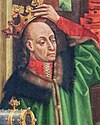
|
Władysław II Jagiełło Władysław II Jagiełło |
1 January 1362 – 7 June 1434 (aged 72) |
2 February 1386 – 7 June 1434 (aged 48) |
Elisabeth of Pilica
Sophia of Halshany |
House of Jagiellon
|
|
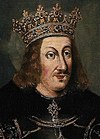
|
Władysław III of Poland Władysław Warneńczyk |
31 October 1424 – 10 November 1444 (aged 20) |
7 June 1434 – 10 November 1444 (aged 10) |
none | House of Jagiellon
|
— |

|
Casimir IV Jagiellon Kazimierz IV Jagiellończyk |
30 November 1427 – 7 June 1492 (aged 64) |
10 November 1444 – 7 June 1492 (aged 47) |
Elisabeth of Austria | House of Jagiellon
|
Vladislaus II of Hungary
Hedwig Jagiellon Barbara Jagiellon |

|
John I Albert Jan I Olbracht |
27 December 1459 – 17 June 1501 (aged 41) |
7 June 1492 – 17 June 1501 (aged 9) |
none | House of Jagiellon
|
— |

|
Alexander I Jagiellon Aleksander I Jagiellończyk |
5 August 1461 – 19 August 1506 (aged 45) |
17 June 1501 – 19 August 1506 (aged 5) |
Helena of Moscow | House of Jagiellon
|
— |

|
Sigismund I the Old Zygmunt I Stary |
1 January 1467 – 1 April 1548 (aged 81) |
19 August 1506 – 1 April 1548 (aged 41) |
Barbara Zápolya Bona Sforza |
House of Jagiellon
|
Sophia, Duchess of Brunswick |

|
Sigismund II Augustus Zygmunt II August |
1 August 1520 – 7 July 1572 (aged 51) |
1 April 1548 – 7 July 1572 (aged 24) |
Elisabeth of Austria Barbara Radziwiłł Catherine of Austria |
House of Jagiellon
|
— |

|
Anna I Jagiellon Anna Jagiellonka |
18 October 1523 – 12 November 1596 (aged 73) |
7 July 1572 – 12 November 1596 (aged 24) |
Stephen Báthory | House of Jagiellon
|
— |

|
Sigismund III Zygmunt III Waza |
20 June 1566 – 30 April 1632 (aged 65) |
12 December 1586 – 30 April 1632 (aged 45) |
Anna of Austria Constance of Austria |
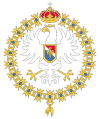 House of Jagiellon-Vasa |
Karol Ferdynand Vasa |

|
Władysław IV Władysław IV Waza |
9 June 1595 – 20 May 1648 (aged 52) |
30 April 1632 – 20 May 1648 (aged 16) |
Cecilia Renata of Austria Marie Louise Gonzaga |
 House of Jagiellon-Vasa |
Sigismund Casimir Władysław Konstanty Vasa |

|
Jan II Kazimierz Jan II Kazimierz |
22 March 1609 – 16 December 1672 (aged 63) |
20 May 1648 – 6 November 1672 (aged 24) |
Marie Louise Gonzaga |  House of Jagiellon-Vasa |
John Sigismund Vasa |
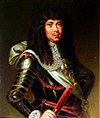
|
Michael I Michał Korybut Wiśniowiecki |
31 May 1640 – 10 November 1673 (aged 33) |
16 December 1672 – 10 November 1673 (aged 1) |
Eleonora Maria of Austria
|
House of Wiśniowiecki
|
— |

|
John III Sobieski Jan III Sobieski |
17 August 1629 – 17 June 1696 (aged 66) |
10 November 1673 – 17 June 1696 (aged 22) |
Marie Casimire Louise de La Grange d'Arquien
|
 House of Sobieski |
James Louis Sobieski Theresa, Electress of Bavaria |

|
Augustus II the Strong August II Mocny |
12 May 1670 – 1 February 1733 (aged 62) |
17 June 1696 – 24 September 1706 (aged 10) |
Christiane Eberhardine of Brandenburg-Bayreuth |  House of Wettin |
|

|
Stanisław I Stanisław I Leszczyński |
20 October 1677 – 23 February 1766 (aged 88) |
24 September 1706 – 12 September 1733 (aged 26) |
Catherine Opalińska | House of Leszczyński
|
Anna Leszczyńska |

|
Augustus III of Poland August III Sas |
17 October 1696 – 5 October 1763 (aged 66) |
12 September 1733 – 5 October 1763 (aged 30) |
Maria Josepha of Austria |  House of Wettin |
Sophia, Electress of Bavaria Franz Xavier Josepha, Dauphine of France |

|
Stanisław II Augustus Stanisław II August Poniatowski |
17 January 1732 – 12 February 1798 (aged 66) |
5 October 1763 – 12 February 1798 (aged 34) |
none | House of Poniatowski
|
Izabela Grabowska
|

|
Frederick I Augustus Fryderyk I August |
23 December 1750 – 5 May 1827 (aged 76) |
12 February 1798 – 5 May 1827 (aged 29) |
Amalie of Zweibrücken-Birkenfeld |  House of Wettin |
|

|
Maria I Augusta Maria Augusta |
21 June 1782 – 14 March 1863 (aged 80) |
5 May 1827 – 14 March 1863 (aged 35) |
none |  House of Wettin |
— |

|
John IV Jan IV |
12 December 1801 – 29 October 1873 (aged 71) |
14 March 1863 – 29 October 1873 (aged 10) |
Amalie Auguste of Bavaria | 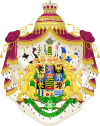 House of Wettin |
|

|
Albert I Albert I |
23 April 1828 – 19 June 1902 (aged 74) |
29 October 1873 – 19 June 1902 (aged 28) |
Carola of Vasa | 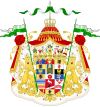 House of Wettin |
— |
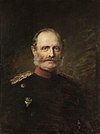
|
George I Jerzy I |
8 August 1832 – 15 October 1904 (aged 72) |
19 June 1902 – 15 October 1904 (aged 2) |
Maria Anna of Portugal
|
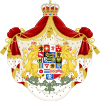 House of Wettin |
Archduchess Maria Josepha |

|
Frederick II Augustus Fryderyk August II |
25 May 1865 – 18 February 1932 (aged 66) |
19 June 1902 – 18 February 1932 (aged 29) |
Louise of Austria |  House of Wettin |
Princess Anna Monika
|

|
Georg II Jerzy II |
15 January 1893 – 14 May 1943 (aged 50) |
18 February 1932 – 14 May 1943 (aged 11) |
none |  House of Wettin |
— |
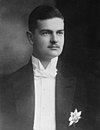
|
Friedrich III Christian Fryderyk III Krystian |
31 December 1893 – 9 August 1968 (aged 74) |
14 May 1943 – 9 August 1968 (aged 25) |
Elisabeth Helene of Thurn and Taxis
|
 House of Wettin |
Emanuel Anna of Saxony Mathilde |
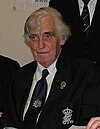
|
Albert II Albert II Józef |
30 November 1934 – 6 October 2012 (aged 77) |
9 August 1968 – 6 October 2012 (aged 44) |
Elmira Henke |  House of Wettin |
— |
Alexander II Aleksander II |
12 February 1954 | 6 October 2012 | Gisela of Bavaria | 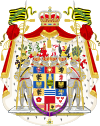 House of Wettin |
Prince Georg Philipp |
Demographics
Polish minorities are still present in the neighboring countries of Germany, Russia, and Sweden, as well as in other countries (see Poles for population numbers). Altogether, the number of ethnic Poles living abroad is estimated to be around 20 million.
|
|
|
|
|
|
|



